详细说明
Species Reactivity
Human
Specificity
Detects human TAFA2/FAM19A2 in direct ELISAs and Western blots. In direct ELISAs and Western blots, no cross‑reactivity with recombinant human TAFA1, 3, 4, or 5 is observed.
Source
Monoclonal Mouse IgG 2B Clone # 447815
Purification
Protein A or G purified from hybridoma culture supernatant
Immunogen
E. coli-derived recombinant human TAFA2/FAM19A2
Ala31-His131
Accession # AAH28403Formulation
Lyophilized from a 0.2 μm filtered solution in PBS with Trehalose. *Small pack size (SP) is supplied as a 0.2 µm filtered solution in PBS.
Label
Unconjugated
Applications
Recommended
ConcentrationSample
Western Blot
1 µg/mL
Recombinant Human TAFA2/FAM19A2 (Catalog # )
Please Note: Optimal dilutions should be determined by each laboratory for each application. are available in the Technical Information section on our website.
Preparation and Storage
Reconstitution
Reconstitute at 0.5 mg/mL in sterile PBS.
Shipping
The product is shipped at ambient temperature. Upon receipt, store it immediately at the temperature recommended below. *Small pack size (SP) is shipped with polar packs. Upon receipt, store it immediately at -20 to -70 °C
Stability & Storage
Use a manual defrost freezer and avoid repeated freeze-thaw cycles.
12 months from date of receipt, -20 to -70 °C as supplied.
1 month, 2 to 8 °C under sterile conditions after reconstitution.
6 months, -20 to -70 °C under sterile conditions after reconstitution.
Background: TAFA2/FAM19A2
TAFA2, also called FAM19A2, is a secreted, 11 kDa member of the FAM19/TAFA family of chemokine-like proteins (1). It is synthesized as a 131 amino acid (aa) precursor that contains a 30 aa signal sequence and a 101 aa mature chain. Like other members of the FAM19/TAFA family, with the exception of TAFA5, mature TAFA1 contains 10 regularly spaced cysteine residues that follow the pattern CX7CCX13CXCX14CX11CX4CX5CX10C, where C represents a conserved cysteine residue and X represents any noncysteine amino acid (1). Human TAFA2 shares 97% aa sequence identity with mouse TAFA2 (1). TAFA2 expression can be detected in the central nervous system (CNS), colon, heart, lung, spleen, kidney, and thymus, but its expression in the CNS is 50- to 1000-fold higher than in other tissues (1). Within the CNS, TAFA2 expression is highest in the occipital and frontal cortex (3- to 10-fold more abundantly expressed than in other cortical regions) and medulla (1). Hypotheses for the biological functions of TAFA family members include modulating immune responses in the CNS by functioning as brain-specific chemokines, acting with other chemokines to optimize the recruitment and activity of immune cells in the CNS (1). Alternately, TAFAs may represent a novel class of neurokines that act as regulators of immune nervous cells (1 - 2). Finally, TAFAs may control axonal sprouting following brain injury (1).
References:
Tang, Y.T. et al. (2004) Genomics 83:727.
Benveniste, E. (1998) Cytokine Growth Factor Rev. 9:259.
Long Name:
Family with Sequence Similarity 19, Member A2
Entrez Gene IDs:
338811 (Human); 268354 (Mouse)
Alternate Names:
Chemokine-like protein TAFA-2; DKFZp761E1217; DKFZp781P0552; FAM19A2; family with sequence similarity 19 (chemokine (C-C motif)-like), member A2; MGC42403; TAFA2; TAFA-2











 粤公网安备44196802000105号
粤公网安备44196802000105号